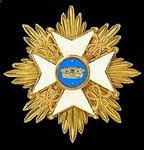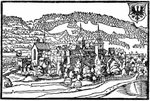Season's Greetings and a Happy New Year to all viewing this blog!
Here at last are the next Prussian flags, of IR24.
The regiment was created 1715 from two former garrison battalions.
In 1756 IR 24 took part with the Royal army in the Pirna campaign. At the battle of Prague on 6th May 1757 it led the left wing in the first attack on the Homole-Berg under Winterfeldt, who was soon wounded and put out of action. Struggling forward under heavy musket and canister fire the regiment was driven back in disorder. The 73 year old General Schwerin, who was its chef, tore a flag from the hands of Captain von Rohr and tried to lead the regiment forward again. In his Army of Frederick the Great 2nd Edition Christopher Duffy describes the scene thus:
"Riding forward he seized a green colour from the hand of a Junker of his second battalion and called out to his men "Heran mein Kinder!". He had scarcely covered twelve paces before he was deluged in canister. One ball took him behind the ear, one in the heart and three in the stomach. His dying hand let the colour fall to the right of the horse and he himself toppled over to the left. His horrified regiment took to its heels."
The image from Knötel above depicts Schwerin about to fall from his horse after being hit and clutching a Leibfahne of the regiment. The second image below is a depiction of his death by J C Frisch with the Leibfahne flag draped beside him. As Christopher Duffy's account above shows, it was a Kompaniefahne of the 2nd battalion that he actually seized.
The regiment lost 13 officers and 522 rank and file. After the breakthrough the regiment was led forward with the rest of Schwerin's wing to besiege Prague.
The regiment fought at Rossbach and the grenadiers at Leuthen. In 1758 the regiment was with Prince Heinrich's corps, securing the south-western flank. He took it with him into Franconia in 1759 but it was then sent by Frederick to join Hülsen's Pomeranian Corps, with whom it lost 37 officers and 933 men in the defeat at Kay against the Russians; its losses were one-sixth of total Prussian losses. It then had the pleasure of fighting against Russians three weeks later at Kunersdorf, in the vicious fight for the Kuh-grund.
In July 1760 it took part in Frederick's abortive siege of Dresden and then, after an exhausting march, in the Prussian victory of Liegnitz, where the Russians and Austrians were prevented from joining forces, followed by the battle of Hochgiersdorf on September 17th. The grenadiers fought to the last man with Fouqué at Landeshut on June 23rd. At Torgau on November 3rd the regiment took part in the second attack on the Süptitz heights but was halted by enemy reserves, losing 10 officers and 699 men.
In 1761 the regiment was on the Mulde in Saxony, watching the Austrians and the Imperial Army. On July 20th the grenadiers and the Guards stormed Ohmsdorf Castle as part of the preparations for taking the Burkersdorf fortifications. Finally, at Freiberg on October 29th as part of Colonel von Diringshofen's Brigade, the regiment was involved in the capture of the heights of St Michael north-west of Brand.
Christopher Duffy's verdict on the regiment is that it was "famous for its quantity of beer-swilling Mecklenburgers. Badly knocked about at Prague, Kay and Torgau but remained one of the best regiments in the [Prussian] army".
And here is a musketeer of IR 24 by Menzel (but shown with the later more bicorn-like hat, not the SYW-style tricorne):
































































